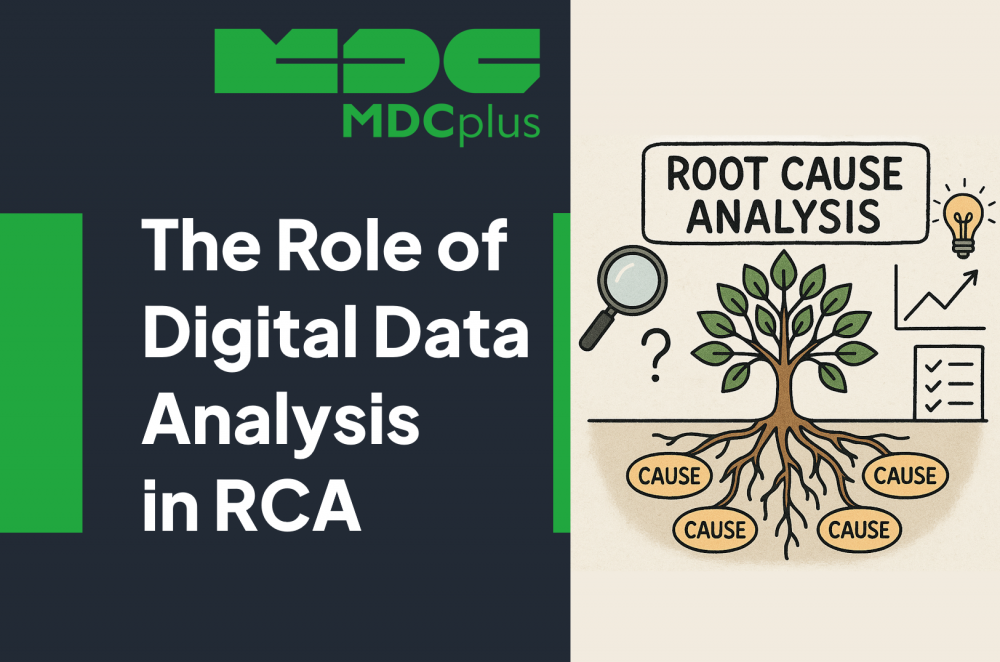No more manufacturing downtimes
Get started with your projectThe Role of Digital Data Analysis in RCA
In the manufacturing sector, maintaining high efficiency and product quality is paramount. When issues arise, identifying their root causes swiftly is crucial to minimize downtime and prevent recurrence. Digital data analysis has revolutionized RCA by enabling manufacturers to delve deeper into their processes and uncover underlying problems more effectively.
What is RCA?
Root Cause Analysis (RCA) is a systematic process used to identify the fundamental underlying causes of problems or incidents, aiming to address these root issues rather than merely treating their symptoms. By focusing on the origin of a problem, RCA facilitates the development of effective solutions that prevent recurrence, thereby enhancing overall organizational performance and reliability.
Digital data analysis involves collecting, processing, and interpreting vast amounts of data generated during manufacturing operations. This data-driven approach enhances RCA in several ways:
-
Comprehensive Data Collection: Modern manufacturing systems are equipped with sensors and IoT devices that continuously gather data on machine performance, environmental conditions, and product quality. This extensive data collection provides a holistic view of the production process, facilitating the identification of anomalies and trends that may indicate underlying issues.
-
Advanced Analytical Tools: Utilizing statistical methods, machine learning algorithms, and artificial intelligence, digital data analysis can identify complex patterns and correlations within the data. These tools can pinpoint subtle factors contributing to defects or inefficiencies that might be overlooked through traditional analysis methods.
-
Real-Time Monitoring and Feedback: Digital systems enable continuous monitoring of manufacturing processes, providing immediate feedback when deviations occur. This real-time insight allows for prompt corrective actions, reducing the impact of potential issues and preventing them from escalating.
-
Enhanced Visualization Techniques: Data visualization tools, such as Ishikawa (fishbone) diagrams, are enhanced through digital analysis, offering clearer and more detailed representations of potential causes of problems. These visual aids assist teams in systematically exploring all possible factors contributing to an issue.
Benefits of Integrating Digital Data Analysis into RCA
-
Increased Accuracy: Data-driven RCA reduces reliance on assumptions and anecdotal evidence, leading to more precise identification of root causes.
-
Efficiency Gains: Automated data collection and analysis streamline the RCA process, allowing teams to address issues more quickly and reduce downtime.
-
Predictive Capabilities: Beyond identifying current issues, digital data analysis can forecast potential future problems by recognizing patterns indicative of impending failures, enabling proactive maintenance and process adjustments.
Challenges and Considerations
While digital data analysis offers significant advantages, its implementation in RCA comes with challenges:
-
Data Overload: The sheer volume of data can be overwhelming. Effective data management strategies and tools are essential to filter and focus on relevant information.
-
Integration with Existing Systems: Ensuring compatibility between new digital analysis tools and legacy manufacturing systems can be complex and may require substantial investment.
-
Skill Requirements: Personnel need training to effectively utilize advanced analytical tools and interpret the results accurately.
About MDCplus
Our key features are real-time machine monitoring for swift issue resolution, power consumption tracking to promote sustainability, computerized maintenance management to reduce downtime, and vibration diagnostics for predictive maintenance. MDCplus's solutions are tailored for diverse industries, including aerospace, automotive, precision machining, and heavy industry. By delivering actionable insights and fostering seamless integration, we empower manufacturers to boost Overall Equipment Effectiveness (OEE), reduce operational costs, and achieve sustainable growth along with future planning.
Ready to increase your OEE, get clearer vision of your shop floor, and predict sustainably?
